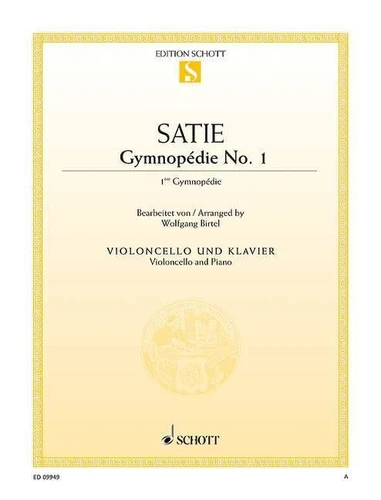1ère Gymnopédie. cello and piano.
Par :Formats :
- Paiement en ligne :
- Livraison à domicile ou en point Mondial Relay indisponible
- Retrait Click and Collect en magasin gratuit
- Réservation en ligne avec paiement en magasin :
- Indisponible pour réserver et payer en magasin
- Nombre de pages4
- Poids0.042 kg
- Dimensions23,1 cm × 30,3 cm × 0,0 cm
- ISBNM-001-18163-7
- EAN9790001181631
- Date de parution01/01/2000
- CollectionEdition Schott - Single Editio
- ÉditeurSchott
- MusicienWolfgang Birtel
Résumé
The music scene took notice of Erik Satie (1866-1925) all of a sudden : The world premiere of his ballet 'Parade' on 18 May 1917 [siehe dt. Text ! ] caused quite a scandal. The production which involved Sergey Diaghilev with his 'Ballets Russes', Pablo Picasso (scenery and costumes), Jean Cocteau (story) as well as Léonide Massine (choreography) divided the music scene of Paris, yet made the composer widely known.
Satie who hardly had had any solid musical training and lived in Paris for almost all his life developed a new musical style, in deliberate rejection of the 'Wagnérisme' of his time. Classical form models, new harmonies, stylistic ease, meditative and clownish elements amalgamated in an original way, the perfect example being his '3 Gymnopédies' of 1888 the first of which was here arranged for a solo instrument with piano accompaniment : Thus, it is now possible, even for non-pianists, to play this famous miniature by Satie.
Thanks to its easy playability, it can also be used for educational purposes. Instrumentation : cello and piano
Satie who hardly had had any solid musical training and lived in Paris for almost all his life developed a new musical style, in deliberate rejection of the 'Wagnérisme' of his time. Classical form models, new harmonies, stylistic ease, meditative and clownish elements amalgamated in an original way, the perfect example being his '3 Gymnopédies' of 1888 the first of which was here arranged for a solo instrument with piano accompaniment : Thus, it is now possible, even for non-pianists, to play this famous miniature by Satie.
Thanks to its easy playability, it can also be used for educational purposes. Instrumentation : cello and piano
The music scene took notice of Erik Satie (1866-1925) all of a sudden : The world premiere of his ballet 'Parade' on 18 May 1917 [siehe dt. Text ! ] caused quite a scandal. The production which involved Sergey Diaghilev with his 'Ballets Russes', Pablo Picasso (scenery and costumes), Jean Cocteau (story) as well as Léonide Massine (choreography) divided the music scene of Paris, yet made the composer widely known.
Satie who hardly had had any solid musical training and lived in Paris for almost all his life developed a new musical style, in deliberate rejection of the 'Wagnérisme' of his time. Classical form models, new harmonies, stylistic ease, meditative and clownish elements amalgamated in an original way, the perfect example being his '3 Gymnopédies' of 1888 the first of which was here arranged for a solo instrument with piano accompaniment : Thus, it is now possible, even for non-pianists, to play this famous miniature by Satie.
Thanks to its easy playability, it can also be used for educational purposes. Instrumentation : cello and piano
Satie who hardly had had any solid musical training and lived in Paris for almost all his life developed a new musical style, in deliberate rejection of the 'Wagnérisme' of his time. Classical form models, new harmonies, stylistic ease, meditative and clownish elements amalgamated in an original way, the perfect example being his '3 Gymnopédies' of 1888 the first of which was here arranged for a solo instrument with piano accompaniment : Thus, it is now possible, even for non-pianists, to play this famous miniature by Satie.
Thanks to its easy playability, it can also be used for educational purposes. Instrumentation : cello and piano
















